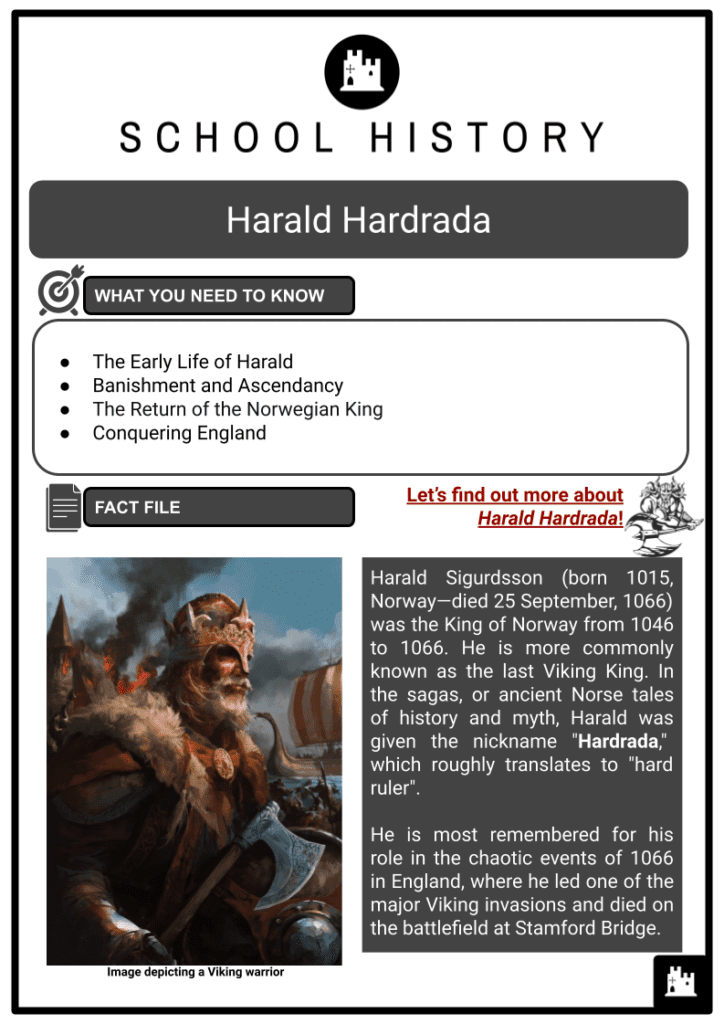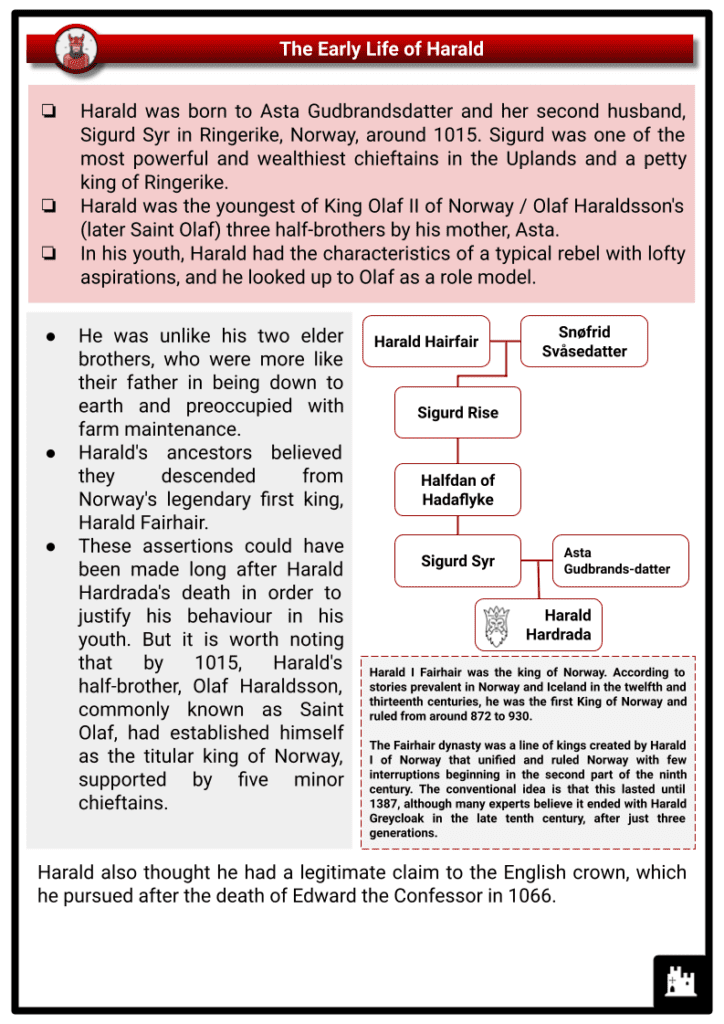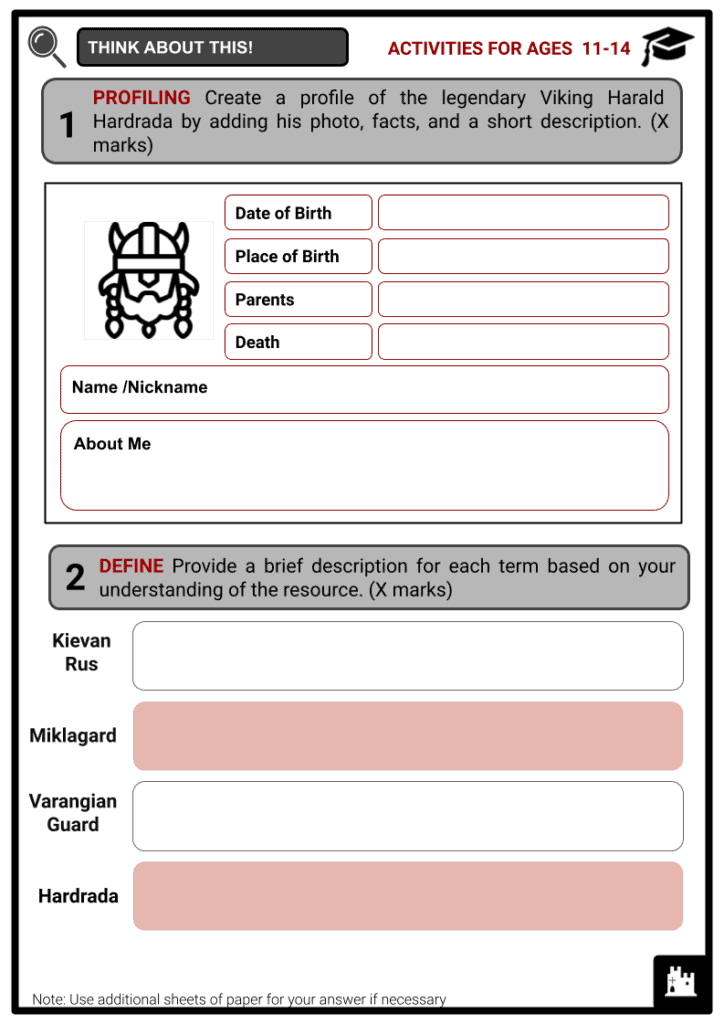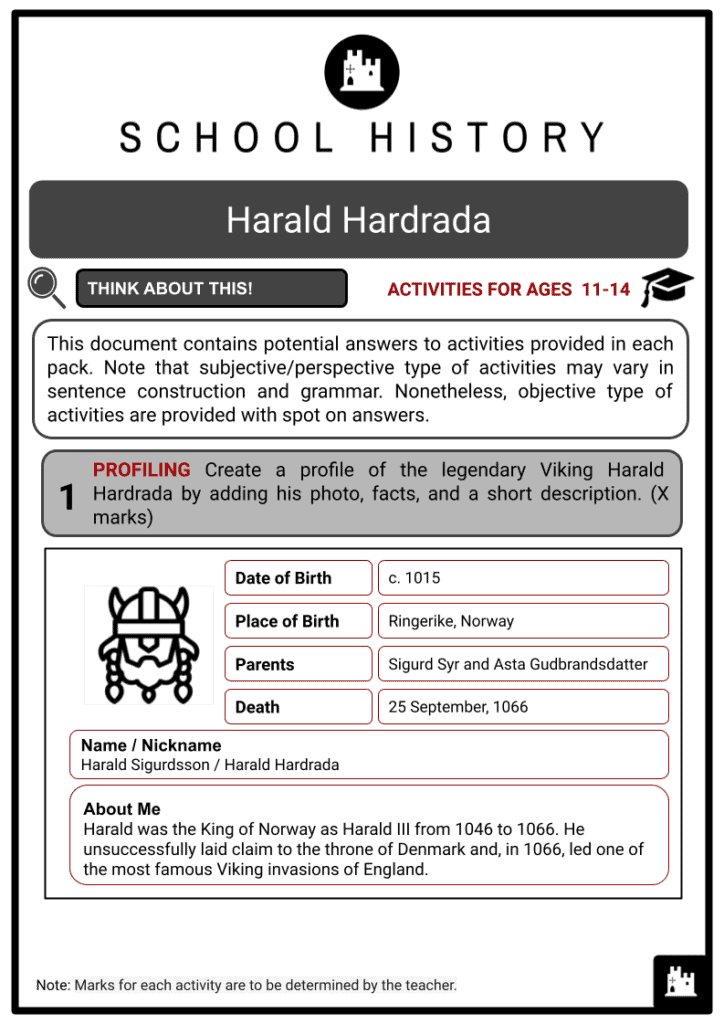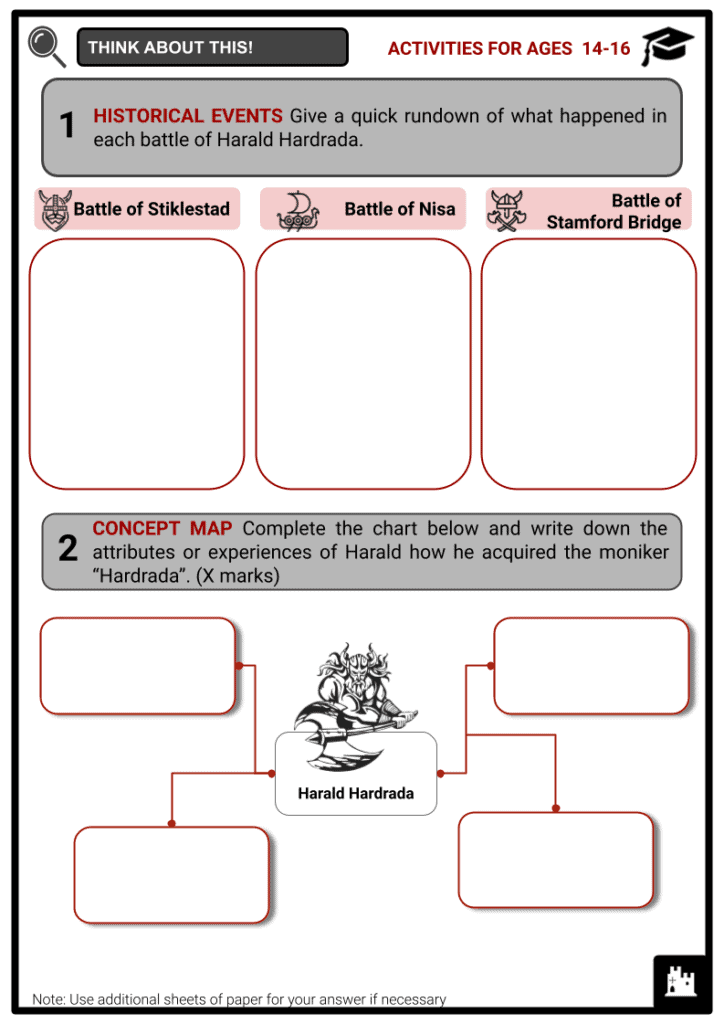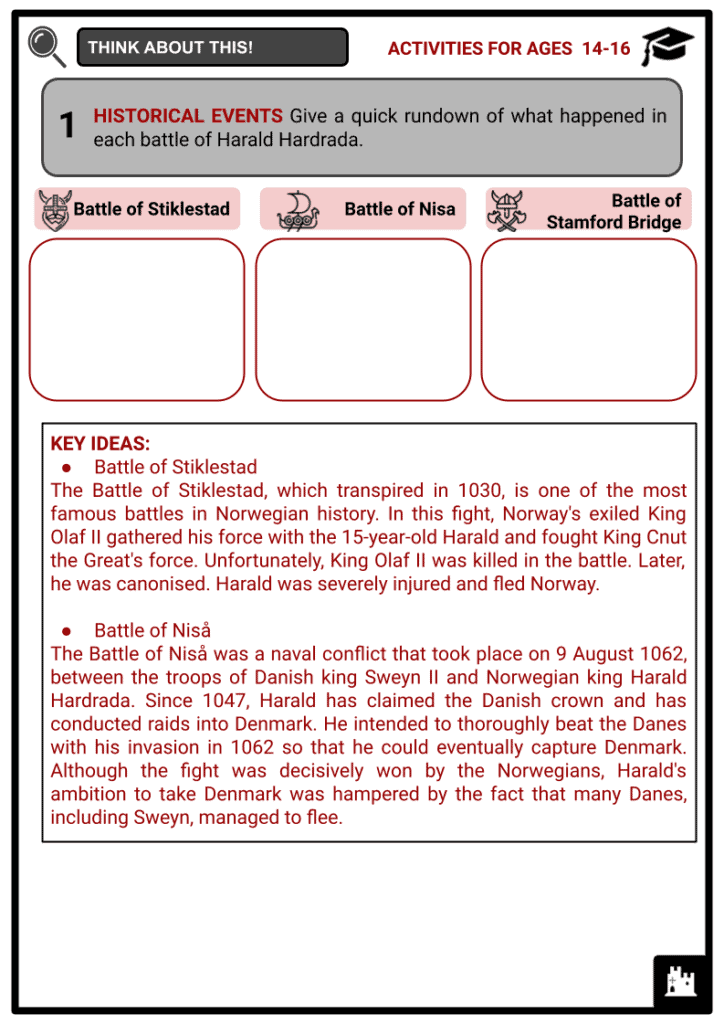Harald Hardrada Worksheets
Do you want to save dozens of hours in time? Get your evenings and weekends back? Be able to teach about Harald Hardrada to your students?
Our worksheet bundle includes a fact file and printable worksheets and student activities. Perfect for both the classroom and homeschooling!
Summary
- The Early Life of Harald
- Banishment and Ascendancy
- The Return of the Norwegian King
- Conquering England
Key Facts And Information
Let’s find out more about Harald Hardrada!
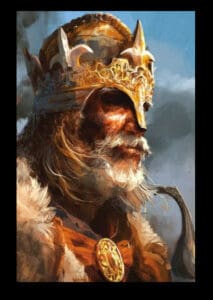
Harald Sigurdsson (born 1015, Norway—died 25 September, 1066) was the King of Norway from 1046 to 1066. He is more commonly known as the last Viking King. In the sagas, or ancient Norse tales of history and myth, Harald was given the nickname "Hardrada," which roughly translates to "hard ruler". He is most remembered for his role in the chaotic events of 1066 in England, where he led one of the major Viking invasions and died on the battlefield at Stamford Bridge.
The Early Life of Harald
- Harald was born to Asta Gudbrandsdatter and her second husband, Sigurd Syr in Ringerike, Norway, around 1015. Sigurd was one of the most powerful and wealthiest chieftains in the Uplands and a petty king of Ringerike.
- Harald was the youngest of King Olaf II of Norway / Olaf Haraldsson's (later Saint Olaf) three half-brothers by his mother, Asta.
- In his youth, Harald had the characteristics of a typical rebel with lofty aspirations, and he looked up to Olaf as a role model.
- He was unlike his two elder brothers, who were more like their father in being down to earth and preoccupied with farm maintenance.
- Harald's ancestors believed they descended from Norway's legendary first king, Harald Fairhair.
- These assertions could have been made long after Harald Hardrada's death in order to justify his behaviour in his youth. But it is worth noting that by 1015, Harald's half-brother, Olaf Haraldsson, commonly known as Saint Olaf, had established himself as the titular king of Norway, supported by five minor chieftains.
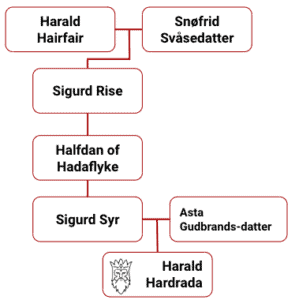
- Harald I Fairhair was the king of Norway. According to stories prevalent in Norway and Iceland in the twelfth and thirteenth centuries, he was the first King of Norway and ruled from around 872 to 930. The Fairhair dynasty was a line of kings created by Harald I of Norway that unified and ruled Norway with few interruptions beginning in the second part of the ninth century. The conventional idea is that this lasted until 1387, although many experts believe it ended with Harald Greycloak in the late tenth century, after just three generations.
- Harald also thought he had a legitimate claim to the English crown, which he pursued after the death of Edward the Confessor in 1066.
Banishment and Ascendancy
Battle of Stiklestad
- Harald's dynasty had a tense relationship with the Norwegian crown, which the famous King Cnut the Great (Canute) of Denmark had usurped in 1029. A feud sprang out between the new king's supporters and Harald's family, and Olaf was sent into exile as a consequence.
- Olaf returned to Norway two years later to retake his throne, and his half-brother Harald gathered 600 soldiers in an invasion to support him.
- At the age of 15, Harald made his imprint on history with his older half-brother King Olaf II (later Saint Olaf) at the battle of Stiklestad against Danes loyal to Cnut the Great in 1030.
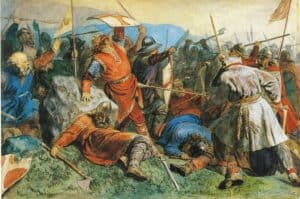
King Olaf II's demise in the Battle of Stiklestad, July 1030 - The brothers were crushed. Olaf was killed during the battle while Harald was gravely wounded and forced to escape. Despite losing the fight, Harald displayed tremendous military skill.
Kievan Rus
- Despite the serious injuries, Harald managed to flee to an unnoticed isolated farm in Eastern Norway with the help of Rögnvald Brusaso. After a month or two of rest, he ventured north and bravely traversed the Swedish Alps.
- In 1031, a year after the catastrophic Battle of Stiklestad, the young Harald Hardrada pushed his way into Kievan Rus' domain (possibly by arriving at the town of Staraya Ladoga or Aldeigjuborg).
- The Rus Grand Prince, Yaroslav the Wise greeted Harald with open arms, recognising him as the half-brother of Saint Olaf, who previously took refuge in Kievan Rus during his exile.
- Kievan Rus' was an Eastern and Northern European state from the late 9th until the middle of the 13th century. The Rurik dynasty, established by the Varangian prince Rurik, governed the region. It is situated in present-day Ukraine, Belarus, and a portion of Russia.
- Ingegard, the wife of Yaroslav the Wise, was a Swedish princess and distant relative of Harald.
- Yaroslav was in great need of military commanders, so he named him a captain of his soldiers after recognising his link to Olaf and his comparable abilities. It is believed that Harald participated in several campaigns, including those against the Poles, Chudes, Byzantines, and Pechenegs.
- After assisting Yaroslav in Kyivan Rus for a few years, Harald and his troops set out to explore further south.
The Byzantines
- Harald and his soldiers landed at Constantinople, the capital of the Eastern Roman Empire, or the Byzantine Empire as it was called, around 1034. The Norsemen referred to it as Miklagard, derived from the words Mikil, meaning 'large,' and Garr, meaning 'wall,' together indicating “stronghold”.
- Harald was able to get position as a member of the renowned Varangian Guard, which served as the elite bodyguard regiment for Emperor Michael IV of the Eastern Roman Empire.
- Varangian Guard consisted of soldiers from Northern Europe, Scandinavia, and Britain which served as the Emperor's personal bodyguard.
- This made it so the guards could be trusted upon to deal with any threats or uprisings, since they would be untainted by local politics and rivalries.
- While the primary purpose of the Varangian Guard was to serve as the emperor's bodyguard, Harald was found fighting on almost every boundary of the realm. First, he participated in wars against Arab pirates in the Mediterranean Sea, and later in cities in Asia Minor that had sided the pirates.
- Harald's troops were soon engaged in battle everywhere and fought their way from the Mediterranean through the Tigris and Euphrates and eventually to Jerusalem. Harald quickly rose to the position and became the leader of the Varangian Guard due to his popularity with Michael IV, the Emperor.
- According to poet jóólfr rnólfsson, Harald fought in eighteen major conflicts while serving the Byzantine Empire. Harald's standing at the imperial court rapidly plummeted after Michael IV's death in December 1041, followed by disagreements between the new emperor Michael V and the powerful empress Zoe.
- During the turmoil, Harald was incarcerated. He then escaped the Eastern Roman Empire and boarded a ship towards the North back to Kiev.
The Return of the Norwegian King
- Harald became incredibly wealthy during his time in the east, and he protected the gold he acquired in Constantinople by transporting it to Kievan Rus' (with Yaroslav the Wise acting as safekeeper for his fortune).
- Following his escape from Constantinople, Harald returned to Kievan Rus' in 1042, where he visited Yaroslav the Wise once again.
- During his second visit, he wed Elisabeth, who was the daughter of Yaroslav the Wise and the granddaughter of Olof Skötkonung, King of Sweden. Yaroslav invaded Constantinople soon after Harald arrived in Kiev, and it is believed that Harald gave him crucial information on the state of the empire.
Claiming the Throne
- It is possible that the money Harald earned while serving in Constantinople enabled him to finance his claim to the Norwegian throne. Harald began his westward voyage in early 1045, going from Novgorod (Holmgard) to Staraya Ladoga (Aldeigjuborg), where he acquired a ship, in an effort to reclaim the kingdom lost by his half-brother Olaf Haraldsson.
- One of his nephews, Magnus the Good, had claimed the throne of Norway in his absence.
- Magnus had succeeded Cnut the Great as king because Cnut the Great's sons had chosen to battle over England rather for Norway, and because Harold Harefoot and Harthacnut, Cnut the Great's sons and heirs, had both passed away at a young age.
- During his eleven-year rule, there are no records of any internal threats or uprisings. Magnus was also chosen to be the king of Denmark after Harthacnut's passing left the position empty. He overcame Sweyn Estridsson, a rival for the Danish throne, to become the next ruler.
- Harald arrived by sea in the town of Sigtuna in Sweden, by 1046 CE. He teamed up with Sweyn Estridsson and the Swedish king, Anand Jacob, in an effort to defeat Magnus.
- In any event, the people refused to rally against Magnus, and upon learning of Harald's plots, Magnus (who was overseas at the time) returned to Norway with his whole army.
- Magnus' counsellors advised the young king not to attack his uncle, and an agreement was negotiated in 1046 wherein Harald would jointly rule Norway (not Denmark) with Magnus, although Magnus would have precedence.
- Notably, Harald had to agree to share half of his fortune with Magnus, who was bankrupt and desperately in need of finances at the time. During their brief co-regency, Harald and Magnus maintained separate courts and kept to themselves; their sole known encounters almost resulted in violent conflict.
- Magnus and Harald led a leidang force to Denmark in 1047. After less than a year of joint leadership, Magnus passed away in Jylland later that same year. He had already determined before his death that Sweyn would inherit Denmark and that Harald would take over Norway.
- After hearing of Magnus' death, Harald promptly summoned the Norwegian chiefs and proclaimed himself King of Norway and Denmark.
- And thus, 18 years after Olaf's removal, Harald finally became King of Norway.
During his reign
- It was during Harald's reign that the Norwegian monarchy established its exclusive right to mint currency. It would indicate that coins made under Harald's reign were widely circulated (as opposed to continued use of primarily foreign-minted coins).
- Harald most certainly made a sizable sum of money every year through the minting of coins. In the late 14th century, Norway stopped minting its own currency.
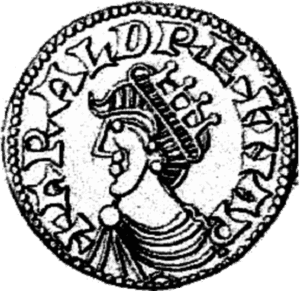
Coin depicting Harald as the sole king of Norway - Harald, having seized the throne by force, would have to persuade Norway's nobility that he was fit to manage the country on his own. He wed Tora Torbergsdatter, a member of one of Norway's most influential families, to strengthen his position at home.
- Principal adversaries to Harald's reign would be the descendants of Haakon Sigurdsson, who had ruled Northern Norway and Trndelag with considerable autonomy under the Norwegian monarch. Haakon controlled all of Norway (officially under the Danish monarch) from 975 until 995, when he was assassinated during Olaf Tryggvasson's conquest.
- Einar Thambarskelfir, who was married to Haakon's daughter, led the family throughout the early years of Harald's rule. Haakon's descendants retained a degree of power in the north even after his death. Even though the family had maintained cordial connections with Magnus, Harald's absolutism and consolidation of the throne led to conflict with Einar.
- Harald's power clash with the Norwegian nobles earned him the notoriety that earned him the title "Hardrada" or "The Harsh Ruler."
- Einar once appeared at Harald's court at Nidaros escorted by eight or nine longships and over five hundred warriors in a clear attempt to provoke conflict.
- This resulted in Einar's murder by Harald's soldiers, which threatened to drive Norway into civil war.
- Although the surviving descendants of Haakon Sigurdsson pondered revolting against the king, Harald was able to negotiate peace with them and ensure their submission for the duration of his reign.
- Harald's rule was distinguished by his past as a military leader, since he frequently used sheer force to settle conflicts.
- Harald is regarded as having enacted sensible economic policies, since he established a Norwegian currency and a functioning coin economy, enabling Norway to take part in international commerce. Through his ties, he established commerce with Kievan Rus', the Byzantine Empire, Scotland, and Ireland.
Invading Denmark
- Harald also desired to reestablish Magnus' control over Denmark and, in the long run, perhaps planned to restore the entirety of Cnut the Great's "North Sea Empire." While his initial plan to conquer Denmark failed, the next year Harald launched what would become almost constant battle against Sweyn from 1048 until 1064.
- The majority of his battles against Sweyn consisted of rapid and brutal attacks on Danish coastlines.
- In 1048, he ransacked Jutland, and in 1049, he plundered and burnt Hedeby, the largest and most prosperous Danish trading city at the time.
- The second and more significant naval fight was the Battle of Nisa on 9 August 1062. Harald desired a decisive victory against Sweyn since he had been unable to subjugate Denmark despite his raids. Eventually, he left Norway with a large army and a fleet of around 300 ships.
- The fight was decisively won by the Norwegians, but as many Danes, including Sweyn, managed to flee, it was inconclusive in Harald's attempt to seize Denmark.
- Fatigue and the high cost of the indecisive conflicts ultimately drove Harald to make peace with Sweyn, and the two kings signed an unconditional peace treaty in 1064. According to the agreement, they would keep their separate kingdoms with their old borders, and no reparations would be paid.
Conquering England
- In England, Cnut's son Harthacnut ruled until his death without an heir in 1042. Harald claimed he was entitled to the throne based on an agreement between Magnus and Harthacnut that said they would inherit each other's kingdoms upon their deaths.
- Harald believed that this privilege belonged to him, and he was enraged when he learned that Edward the Confessor, who had claimed the crown in 1045, had transferred it to Harold Godwinson upon his death in 1066.
- In March or April 1066, Harald began assembling his fleet at Solund in the Sognefjord. This operation was concluded by the beginning of September 1066 and included his flagship, the Ormen, or Serpent. Before departing Norway, he had his son, Magnus Haraldsson crowned king and took Elisiv, his daughters, and Olaf with him. He left Tora behind.
- He allied himself with Harold's brother Tostig Godwinson, who had been deprived of his earldom of Northumbria by King Edward the Confessor, Harold's predecessor.
- King Harald Hardrada was joined by more chieftains and warriors in Shetland and Orkney (both under Norwegian power), including the Earls of Orkney and perhaps Malcolm III of Scotland (the King of Scots), who may have supplied Harald's invading army with 2,000 Scottish men.
Battle of Fulford
- Harald and Tostig likely arrived at the River Tees after departing from Tynemouth. After entering Cleveland, they began ravaging the seashore. The first resistance they faced was in Scarborough, when Harald's demand for surrender was met with opposition. Harald ultimately resorted to burning down the city, which led to the submission of other Northumbrian cities.
- Harald and Tostig continued their raiding expedition across the Humber and landed at Riccall on 20 September. Earl Morcar of Northumbria and Earl Edwin of Mercia heard about the early assaults and met Harald's invading force at the Battle of Fulford, which took place three kilometres south of York.
- York surrendered on 24 September after the fight was won decisively by Harald and Tostig.
Battle of Stamford Bridge
- On the morning of 25 September, Harald and Tostig led the bulk of their troops away from the Riccall landing site. They only took light armour since they planned on meeting the people of York at Stamford Bridge to vote on who would run the city for Harald, as had been agreed upon the day before.
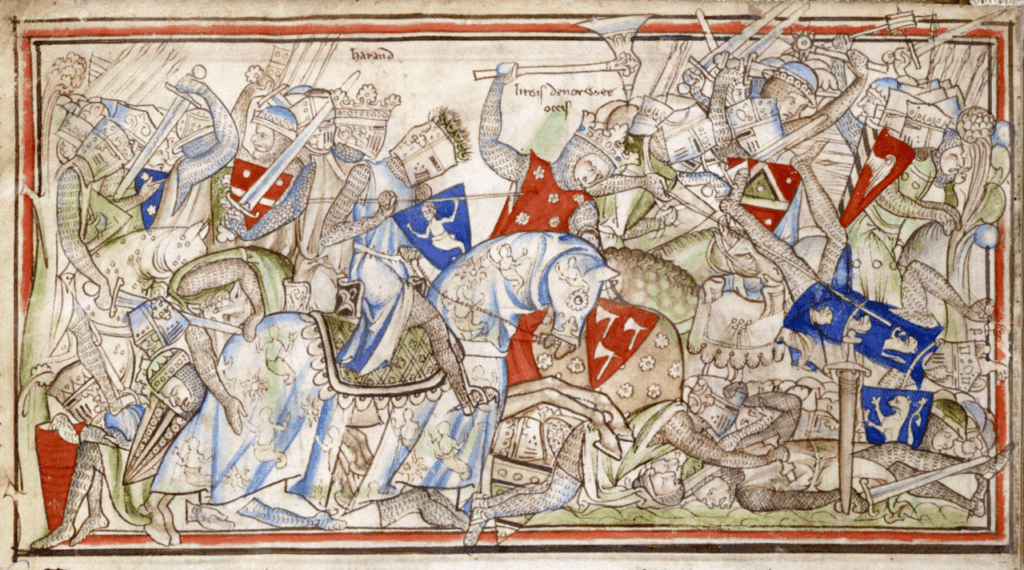
Harald Hardrada at Stamford Bridge - Once there, Harald discovered Godwinson's well-armed, heavily armoured, and vastly outnumbered soldiers advancing. The decision of the Norse army to abandon their armour put them at a significant disadvantage. Eventually, the Norse army began to disintegrate, allowing the English forces to breach the Scandinavians' shield wall and gain entry. The Norwegian army dissolved and was nearly slaughtered as a result of being completely outflanked.
- In the end, Harald's army was decisively defeated. Harald was said to fight like a true berserker and was fatally wounded by an arrow to the throat and slain early in the combat, despite not wearing body armour and fighting fiercely with both hands on his sword.
- The remaining soldiers continued to fight, but were finally vanquished. They escaped to Norway before returning.
- The incredible life of the final "great Viking" came to an end with the decisive Battle of Stamford Bridge in 1066 CE, which also marked the end of the Viking Age.
Aftermath
- Although Harold had vanquished the Norwegians, he was subsequently defeated himself, falling to William the Conqueror in the Battle of Hastings and handing over England to the Normans. Many people believe Harold lost the ultimate battle because he first had to overcome Harald.
- William the Conqueror became William I of England after his victory in the Battle of Hastings.

